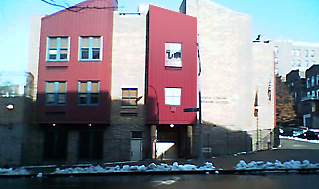P.S. 226
1950 Sedgwick Avenue north of Burnside Avenue
The School Construction Authority
Addition:
1910 Sedgwick Avenue at Burnside Avenue
The School Construction Authority
The area around Burnside and Sedgwick Avenues exhibits signs of many of its stages of development. There are nineteenth century mansions on the campus of nearby Bronx Community College, single-family frame houses from the late nineteenth and early twentieth centuries, brick apartment houses from the 1920s and 1930s, high-rise residencies from the 1960s, and attached town houses from the 1990s. At each period, the influx of new residents created a demand for new schools to educate young people. The construction of P.S. 226 was part of the response to this demand.
P.S. 226 was erected on an unusual site. The western terminus of Burnside Avenue descends in a steep hill to meet Sedgwick Avenue. At that point, Sedgwick Avenue forms a depression from which it rises as a hill going northward. Paralleling it in a steeper hill one block to the east is Osborne Place. The intersection where the three thoroughfares almost converge is rounded rather than angular.
The school, now officially the Nadia J. Pagan Primary School 226, was built in two parts. In 1996, a three-story structure with basement was erected at the corner as an addition to the original building to the north. The base consists of varied size cut stone blocks, upon which rests a yellow brick wall. The Burnside Avenue façade follows the rounded intersection. Jutting from the wall are maroon-colored metal projections with windows.
The main entrance facing Burnside Avenue is flanked with rounded columns that taper from the top down to the bottom. On the Osborne Place side, part of the roofline of two projections almost rises to a peak, but the sides never meet, almost as if it were a baroque split pediment. The split, however, is carried down the height of the building’s brick wall. At the northern end, the roofline rises again, but has no parallel counterpart.
In 1986, the original one-story structure to the north was built. The 1996 addition was attached to the original school. On the Sedgwick Avenue side, at that point, there is a concrete staircase resting on a striated base reminiscent of brutalism architecture. At the top landing are four square columns each with a red brick base with yellow brick above, all supporting an open lattice metal pyramid. This staircase leads to an open area on the roof with doors providing more access to the interior of the original building and with access to a new playground area placed on the roof of the addition. North of the staircase, the structure is separated from the street by a low wall with an iron fence resting on a brutalism style base behind which is vegetation and trees. A similar separation is found on the Osborne Place side, but the steepness of the street precludes the need for a wall, and the building there lays well below street level. The base of this façade on Sedgwick Avenue is a dull red brick band bearing a diamond pattern of yellow brick reminiscent of art deco design. Above that, the façade is yellow brick surmounted by a maroon metal eave. The length of the roof of the entire original building is peaked and made of maroon colored metal strips.
At the center of the original building is a concrete staircase leading to the classroom level. The entryway is flanked by yellow brick with horizontal dark red brick bands. Above the doorway is an arched window surmounted by a peaked roof extending above the roofline. This part of the structure extends across the width of the building to the Osborne Place façade, which is accessed by a multilevel staircase descending from the steep hill on that side.
North of that staircase and entryway, the entire wall of the Sedgwick Avenue façade projects beyond the building line with a series of three peaked roofs, each section defined by angular metal antas. Over the windows in the pediment area on each side section is a semicircular window, while a triangular window occupies the same space in the center section. North of this projection, the façade returns to the normal building line. Near the northern end is a staircase and entryway similar to that found in the center of the original building. The entire structure ends with another, shorter, single floor.
P.S. 226 is a thoroughly modern structure, despite having elements adapted from the classical, baroque, art deco and brutalism styles of the past. It helps the school fit in architecturally with much of its surroundings. The use of similar materials and colors in both the original structure and the addition gives the building a unity it might otherwise lack, while its use of contrasting colors and diverse materials throughout make the whole attractive. Its scale is human, rather than monumental; its effect is welcoming, rather than forbidding.
Lloyd Ultan
